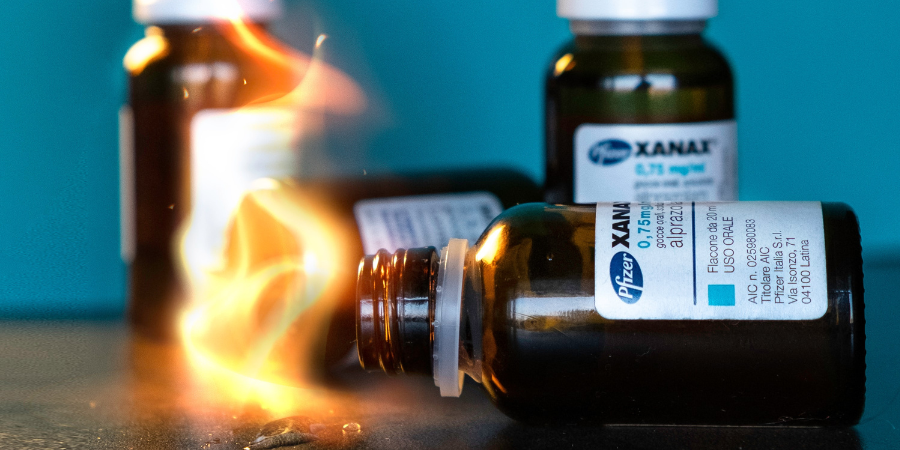
Written by:

Medically Reviewed by:
Last Updated:
March 28th, 2025
Xanax detox
Addiction to Xanax, also known as Alprazolam, is almost always accompanied by physical and psychological dependence, making it difficult to quit. Sudden cessation of Xanax use is never recommended as you may be exposed to severe withdrawal symptoms. To ensure your comfort and safety throughout the Xanax detox and withdrawal period, it is recommended that you go through this stage under the supervision of medical professionals via Xanax rehab treatment.
There are several options for Xanax detox and withdrawal, including outpatient care and private, inpatient treatment facilities, with the latter providing the highest chances of success. The UKAT team is here to help you find the best Xanax treatment option for you.

Xanax withdrawal
Similarly to what happens in benzodiazepine addiction, Xanax affects a neurotransmitter in the brain, known as GABA, and its primary receptor. This impacts the central nervous system and slows brain activity, producing a calming and relaxing effect on the mind and body. The brain, in turn, tries to counteract by triggering increased production of another brain chemical known as glutamate. If you attempt to reduce your Xanax intake, it may take your body some time to adapt, and the excess glutamate can trigger withdrawal symptoms.
Xanax is usually prescribed in small doses to treat anxiety and panic disorders. It is a highly addictive drug, however, and it is possible to see addiction and dependence take hold of the user quickly. Alongside dependence, you will see symptoms of withdrawal any time you try to reduce your dosage or stop taking the drug.
Symptoms of withdrawal may include:
- Headaches
- Muscle aches and pains
- Nausea and vomiting
- Diarrhoea
- Depression and anxiety
- Irritability and agitation
- Feelings of panic
- Blurred vision
- Insomnia
- Extreme fatigue
- Tremors
- Loss of concentration
Symptoms of withdrawal typically begin within six to twelve hours of your last dose, with the severity of your symptoms depending on the extent of your Xanax use. The most severe withdrawal symptoms are associated with sudden stoppage, and so it is advised that Xanax detox takes place gradually, with experienced professionals on hand to guide you.
Xanax detox timeline
Unlike other drugs, the Xanax detox timeline can be difficult to predict. Unfortunately, this is one of the biggest challenges for users attempting to quit the drug. General Xanax withdrawal symptoms that are not too severe can subside within four to five days. Acute or protracted symptoms, however, can take much longer, with symptoms peaking at around ten to fifteen days, and then taking another week or two to abate.
Patients who exhibit only general withdrawal symptoms within the first three or four days are at risk of also exhibiting rebound symptoms. Rebound symptoms refer to the initial symptoms that Xanax was prescribed to alleviate, for example, anxiety or feelings of panic. Those suffering from rebound symptoms may experience anxiety or feelings of panic to a greater degree compared to the original feelings they once had.
Managing Xanax withdrawal
Managing Xanax withdrawal symptoms is not easy to do, and it is therefore advised that you seek the help of medical experts. Attempting to manage symptoms on your own puts you at a high risk of relapse as you may be unable to cope.
During a medically-supervised Xanax detox, your symptoms will be managed by:
- Administering prescription medications
- Administering over-the-counter medications
- Psychotherapeutic interventions
- Strategies to make you as comfortable as possible
Our doctors will perform an initial assessment to determine the medications required, being careful to tailor this to your own individual needs and remove the risk of another addiction forming. You may be given other longer-acting benzodiazepines, for example, diazepam, to lengthen the time needed between doses and lessen any withdrawal symptoms.
It is possible that SSRI antidepressants may be used to mimic the effects of Xanax while still allowing the body to withdraw. Other medications that may be prescribed include medications that treat insomnia and anti-seizure medications.
The risks associated with quitting Xanax ‘cold-turkey’ are too high, and therefore doctors generally prefer to gradually reduce, or ‘taper’, your Xanax dose. This may be a direct taper (using gradually lesser doses of Xanax itself), or substitute tapering (using a replacement drug in place of Xanax).
Possible complications of Xanax withdrawal
Every detox and withdrawal scenario carries with it certain risks, and complications can always occur. Xanax withdrawal is no different. During your Xanax detox, medical staff will look for signs of the following potential complications:
Heart palpitations are a common side effect of Xanax withdrawal. Increased heart rate can lead to palpitations, which can later lead to cardiac arrest. Medical personnel will monitor the patient’s heart rate throughout the entire withdrawal process.
Seizures, although rare, do occur from time to time. They can range anywhere from mild to serious, lasting from a few minutes to ten minutes or longer. The biggest dangers associated with seizures are respiratory arrest, cardiac arrest, and accidental injuries.
Hallucinations also pose a risk to those experiencing Xanax withdrawal. Hallucinations are almost always visual, but they can be auditory or tactile in rare cases. Hallucinations can be dangerous in that they can prompt people to engage in hazardous behaviour.
Psychosis is another potential risk during Xanax withdrawal. Medical science defines psychosis as the inability of a person to think rationally. Xanax-related psychosis can last anywhere from a couple of days to years.
Suicidal thoughts are an especially concerning risk during Xanax withdrawal. This is a serious complication for obvious reasons.
Cognitive decline remains a risk whilst using Xanax, and can be exacerbated in the withdrawal period too, resulting in decreased cognitive ability.
Facing Xanax detox and withdrawal alone is not a risk worth taking – ensure your own safety and peace of mind by contacting UKAT today. Our experienced team is here to help you on your journey to sobriety, encouraging you to take a step back and focus on your recovery.
Next steps
Unfortunately, your recovery process does not end with Xanax detox; you will need ongoing rehabilitation treatment and aftercare to ensure your chances of staying clean. Our team is happy to guide you through each step and offer our support and care as you begin to turn your life around.
If you or a loved one is suffering from Xanax addiction and would like to get help, don’t delay reaching out for support.




